Ever wonder what RVers are talking about? Understanding camping vocabulary can be a challenge. I remember when I started RVing and had no idea what some of the terms meant. This RVing Glossary is to help you learn the lingo. Please drop a comment below with terms you’d like me to add.
A
A-Frame: A-Frames are a type of pop-up camper. But rather than having soft sides, they have a hard shell roof that peaks at the center when assembled. The roofline resembles an “A” shape which means the interior has ample standing room. Most models also have windows or vent fans on the roof bringing in lots of light and ventilation.

A/C: Abbreviation for air conditioner.
Adjustable Ball Mount: An adjustable ball mount is a special hitch that can be adjusted up or down.
Airbag: In RV terms, a shock-absorbing device located at the forward and rear axles of a motor home. Also used in 5th wheel hitches.
Airstream: An iconic type of travel trailer easily recognized by its shiny aluminum exterior.
Airstreaming: A term used by Airstream owners referring to camping and or traveling in an Airstream travel trailer.
Aluminum Exterior Sidewalls: This term refers to the outer layer of your RV. They generally have a wooden frame with an aluminum exterior and batten insulation.
Aluminum Framed Construction: This is a type of construction using aluminum framing for the RV’s sidewalls. It is lighter, water-resistant, and stronger.
Anode Rod: A magnesium or aluminum rod installed in water heaters to protect from the build-up of rust. It corrodes first protecting other metals in the unit by corroding first. These should be inspected regularly and replaced as needed.
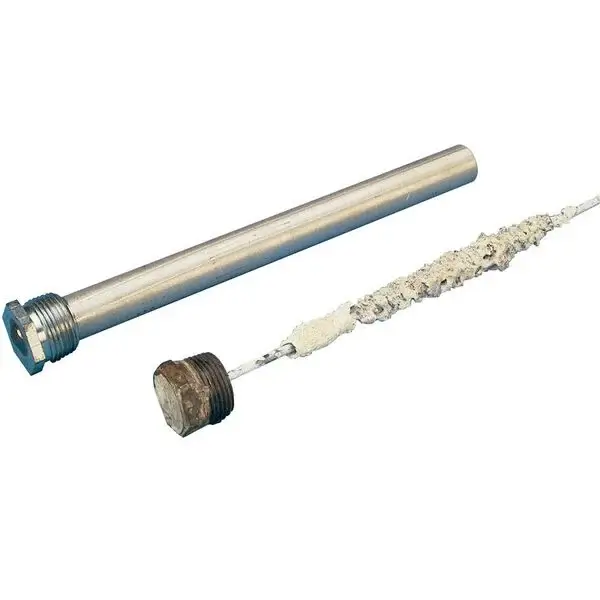
Awning: An awning is installed on the side of an RV. It provides shade. Some are automatically deployed and retracted by pressing a button. Others have steps that you can take to make them work manually.
Automatic Leveling: This is a system on some RVs that level themselves electronically.
Auxiliary Battery: Refers to a motorized RV that has a dedicated battery for starting the engine. The auxiliary batteries are separate and run 12-volt appliances such as lights, refrigerators, furnaces, fans, etc. Also called the house battery.
B
Back-up Camera: A backup camera is a camera installed on the back of an RV that provided the driver with a rearview to assist the driver in backing up. A monitor is usually located in the dashboard of the RV.
Basement: The storage area underneath your RV’s floors. Accessible through doors from outside. Also called storage bays.
Batwing: a TV antenna that resembles a pair of wings. Typically located on the roof of the RV.
Black Water Capacity: The amount of waste from the toilet that your RV’s black water tank can hold.
Black Water Tank: Black tanks are large black plastic compartments that hold the sewer waste in an RV. It is generally located beneath the toilet.
BLM Bureau of Land Management: Federal government agency charged with managing public lands.
Blue Boy: A portable holding tank used to transport waste from your camper to a dump station.
Booth Dinette: A fixed dining area with bench seats on opposite sides of a table. Many RVs have booth dinettes that convert to an extra sleeping space.
Breakaway Cable: A cable attached on one end to the breakaway switch (see below) and the tow vehicle on the other end.
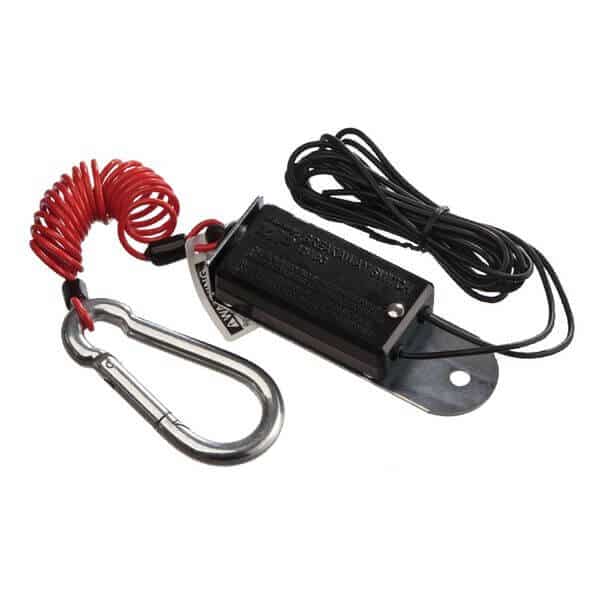
Breakaway Switch: A safety device that will automatically activate the brakes on the trailer if your trailer becomes separated from the tow vehicle while in motion.
Brake Controller: A brake controller is an electronic device that regulates the electric trailer brakes. It allows the driver to activate and adjust trailer brake activity from the cab of the vehicle.
BTU (British Thermal Unit): A BTU in the RV industry refers to a measure of power needed as it relates to furnaces and air conditioners. It’s a measurement of heat; the quantity required to raise the temperature of one pound of water 1 degree F. RV air conditioning and furnace units are BTU-rated.
Bubble Level: Often attached to an RV to assist in leveling your RV.
Bunkhouse: Refers to the floorplan style of an RV that has bunk beds. Popular with families.
Bumper-Mount Hitch: A bumper mount hitch is installed onto a vehicle’s bumper, rather than the frame, and provides a receiver tube for a ball mount, cargo carrier, bike rack, or other hitch-mounted accessories.
Bumper-Pull: A trailer that attaches to a hitch and ball that is attached to the tow vehicle’s frame or bumper.
C
Cab or Cabin: the front driving area of a motorhome or other drivable RV, which includes the driver’s and passenger’s chairs, the steering wheel, and the dashboard. Also known as the cockpit.
Cab-Over: Part of a driveable RV located over the top of the vehicle’s cab, usually containing a sleeping area, storage, or entertainment center.
Camp Host: Camp hosting, park hosting, and workamping are all terms used to describe working while living in your RV. They all include any activity that involves the exchange of labor hours for anything of value. It could be a paycheck, or it could be a free hookup site.
Camper: Another name for an RV.
Camper Shell: A camper shell is a rigid canopy used on the bed of a pickup truck. The housing is usually made of fiberglass or aluminum but can be made of wood or canvas.
Caravan: A caravan is a trailer that has been outfitted for living or camping and can be pulled by a tow vehicle. This term is generally used by people from Europe or the United Kingdom.
Cassette Toilet: A toilet that holds waste in a separate removable container for later disposal. Toilet with a small holding tank that can be removed from outside the vehicle to empty it.
Caster: The angle that identifies the forward or backward slope of a line that is drawn through the upper and lower steering pivot points. It does not affect tire wear, but caster does influence the directional control of the steering.
CCC (Cargo Carrying Capacity): The maximum permissible weight of all pets, personal belongings, food, tools, and other supplies you can carry in your RV This includes the contents of your holding tanks, propane tanks, etc.
Chassis: The framework your RV is built on. In driveable RVs, the chassis generally includes the engine and transmission.
Chassis Battery: A chassis battery is a battery in a motor home that is used primarily for the running of motor functions. Not to be confused with the house or auxiliary battery
Chucking: Exceptionally pronounced back and forth motion experienced during towing, usually caused by a poorly balanced trailer load or uneven roadway.
Class A Motorhome: Class A or type A motorhomes are the largest of RVs and often resemble large buses. Unlike travel trailers, the living and driving area are all one space. They range in length from 26 – 45 feet and run on gas or diesel.
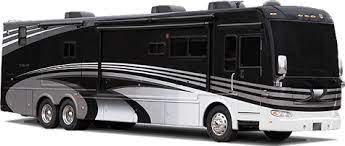
Class B Motorhome: Class B motorhomes are the smallest motorized RVs and are generally built on a minivan chassis and have a raised roof for additional headroom.
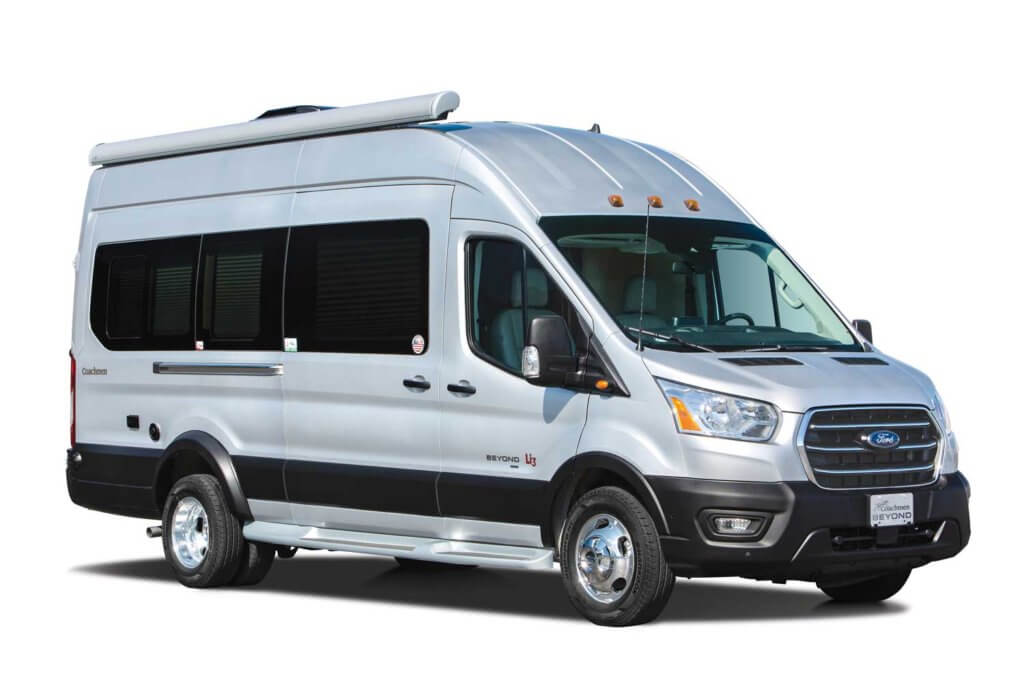
Class B Plus: Class B Plus RV is sized between a Class B and a Class C RV. They are intended to be more maneuverable than larger RVs, yet comfortable.
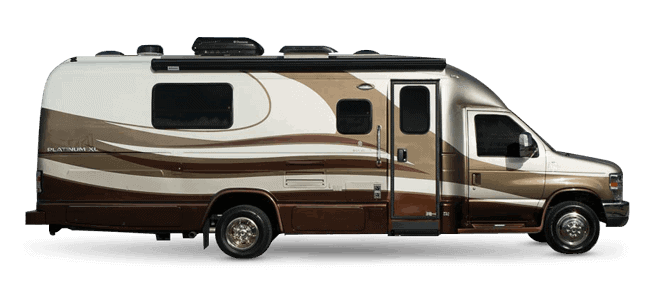
Class C Motorhome: Class C RVs are the next size down from a class A motorhome. They are often built on a truck or van chassis that is specifically designed for a motorhome. They have an attached cab and most have an overhang that extends over the cab. This area is usually used as sleeping quarters but may also be used for storage.
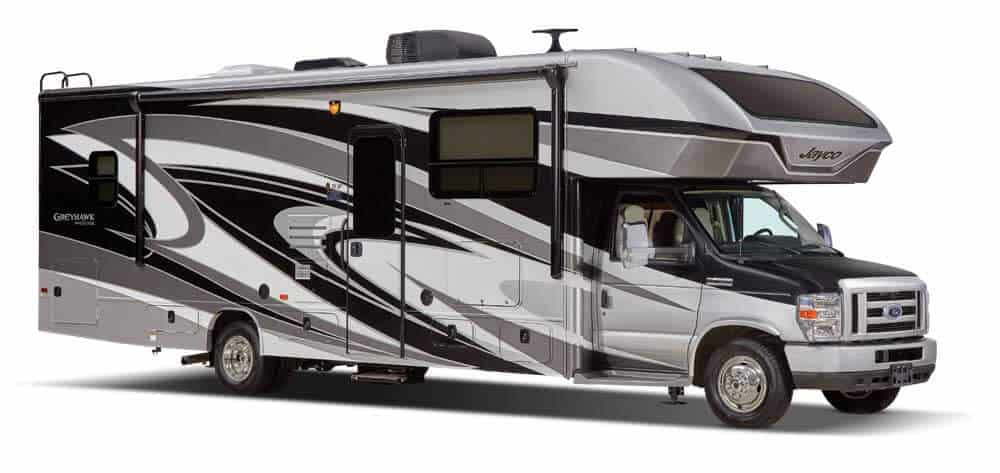
Coach: A class A motorhome. Also known as a Class “A” RV.
Cockpit: The front driving area of a motorhome or other drivable RV, which includes the driver’s and passenger’s chairs, the steering wheel, and the dashboard. Also known as the cab or cabin.
Composting Toilet: A human waste disposal system that utilizes a waterless or low-flush toilet in conjunction with a tank in which aerobic bacteria break down the waste. A popular modification among RVers who like to boondock.
Condensation: The collection of moisture on RV surfaces such as walls, furniture, and personal belonging. This can happen in an RV when the inside of your RV is cool while the outside is humid. Too much condensation can create water damage over time. In damp areas, consider using a dehumidifier.
Control Panel: RVs usually have a panel or cluster of controls where you can control and check holding tank status, and adjust the RV’s systems. Many upscale modern RVs include touchscreen panels for ease of use.
Converter: Converts 120 volt AC power (shore power) to 12-volt DC power and charges your 12-volt house batteries.
Coupler: The part of the trailer that hooks to the hitch ball. Located on the A-frame on a travel trailer.
Crosswise: A piece of furniture arranged across the RV from side to side rather than front to rear. See also, East / West
Curbside: The passenger side of the RV.
Curb Weight: Curb Weight is the actual weight of a vehicle or trailer including all standard equipment, full fuel tanks, full freshwater tanks, full propane bottles, and all other equipment fluids, but before taking on any persons or personal cargo.
D
Delaminated: Delamination is where material fractures into layers. A variety of materials including laminate composites like fiberglass siding on RVs can fail by delamination. This is often due to water damage.
Diesel Puller: Refers to diesel motorhomes with engines located in the front of the RV.
Diesel Pusher: Refers to diesel motorhome with the engine located in the rear of the RV. The engine location helps push the RV down the road and provides a smoother, quieter ride.
Digital Nomad: Digital nomads are people who use telecommunications technologies to earn a living and conduct their life in a nomadic manner. Such workers often work remotely from foreign countries, coffee shops, public libraries, co-working spaces, or recreational vehicles.
Dinghy: the vehicle towed behind a motorhome. Also known as the toad.
Dogbone: A dog bone adapter allows you to hook any RV up to a power source with different amps. For example, some RVs have a 50-amp electric service but may need to convert to a 30-amp service o plugin. A 50-amp to 30-amp dogbone will make this possible. Also called a pigtail.

DSI (Direct Spark Ignition): A Direct Spark Ignition is a device used to light or ignite propane power appliances. Used to describe the method of igniting the main burner on a propane fired appliance.
Dry Camping: This is camping without hookups to any utilities. You may be able to use generator power if permitted. If you prepared in advance you’ll have water from your holding tank. You can dry camp in some state parks, national parks, parking lots, etc.
Dry Weight: The weight of the RV as it comes off the assembly line. Doesn’t include supplies, water, fuel, or passenger weights. Manufacturers weigh each RV and apply a sticker listing the dry weight before shipping.
Dual Electrical System: Most RVs have a dual electrical system. One is a 12-volt system and the other is a 110-volt system. Most RV appliances like lights and your radio run, and your furnace run on the 12-volt system. This system requires an inverter to convert 110-volt power to 12-volt which is then stored in your house batteries. The batteries are charged with plugged into a power source such as shore power, a generator, or your tow vehicle.
Dually: A type of pick-up truck with four tires on the rear axle. These typically pull fifth wheels or large travel trailers.
Ducted Air Conditioning: Refers to air conditioning that is equally distributed through an RV by air ducts much like central air in a home. This allows for better energy usage.
Ducted Heat: Refers to heating that is equally distributed through an RV by air ducts much like central air in a home. This allows for better energy usage.
Dump station: A dump station is a designated location where RVers can dump waste from their grey or black tank. Typically, a concrete pad with a tank underneath the ground.
E
Engine: Provides power to your motorhome, can be diesel or gas-powered.
Engine Oil Cooler: The purpose of the engine oil cooler is to allow the engine’s cooling system to remove excess heat from the oil.
Enclosed/Sealed Underbelly: This term describes an RV whose bottom surface has been closed shut or insulated to help protect against temperature changes.
Entry-Level: A price deemed attractive for first-time RV buyers.
Equalizing Hitch: A weight distribution or equalizing hitch shifts the weight forward towards the rear of the tow vehicle and back at the front of the trailer for even distribution.
Extended Stay Site: Campsite where you can stay long periods of time; up to months or even a whole season.
F
Fiberglass Cap: This refers to the type of material used on the front end of a travel trailer or fifth wheel. Fiberglass material can withstand the rigors of weather and travel better than traditional sidewall caps.
Fifth Wheel, Fiver, 5er, FW: The fifth wheel RV is a trailer that is towed by a pickup truck using a fifth-wheel hitch. It has a split floor plan and usually offers a bigger floor plan than travel trailers.

Floor Plan or Layout: A floorplan is a diagram or drawing of a recreational vehicle that shows where all rooms, appliances, and slide-outs are located.
FMCA or Family Motor Coach Association: An organization that brings motorhome enthusiasts together by providing services, resources, and memberships.
Frameless Windows: Frameless windows are windows that appear to have no frames on the outside of the RV. They are generally dark in color.
Frame-Mount Hitch: A towing hitch mounted directly to the frame of the tow vehicle.
Fresh Water Capacity: The amount of drinkable water an RV’s freshwater tank can hold.
Fresh Water Tank: The freshwater tank holds clean potable water for an RV.
Front Kitchen or Galley: A type of floorplan with the kitchen located in the front section of the RV.
Front Living: A type of floorplan with the living room located in the front section of the RV.
Front Sleeping: A type of floorplan with the master bedroom located in the front section of the RV.
FRVTA: The Florida Recreational Vehicle Trade Association promotes the RV industry through education, leadership, protection, and promotion in Florida. They sponsor many of the RV shows in Florida.
Fuel Type: Type of fuel a drivable RV uses, either gas or diesel.
Full Body Paint: Full Body Paint refers to an RV that has an automobile-type paint job covering the entire body of the RV. This is generally an extra option and costs more, but makes a better quality product.
Full hookups (FHU): Full hookup refers to RV parks or campsites that have connections available for power and sewer.
Full timer: An RVer who lives in their RV year-round. They may be stationary or traveling.
Furnace Ignition Control Board: This is a powered circuit board that automatically gives spark to an open gas valve. New models will try up to three times to give spark if needed.
G
Galley: The galley is the kitchen area in an RV.
Gaucho: A sofa or couch that converts into a sleeping unit.
GAWR (Gross Axle Weight Rating): The maximum permissible weight that can be carried by an axle with weight evenly distributed through the vehicle.
GCWR (Gross Combination Weight Rating): The maximum allowable weight for the combination of the RV, tow vehicle, passengers, cargo, and all fluids (water, fuel, propane, and so on).
Generator: Small engine fueled by gasoline or propane that produces 110-volt electricity, built into many RVs but also available as a portable option.
Gooseneck: One of two styles of fifth-wheel hitches.
Gray water: Wastewater from the sinks and shower.
Gray Water Capacity: The amount of wastewater from sinks and the shower your gray water tank can hold.
Gray Water Tank: The holding tank that holds wastewater from sinks and the shower.
Gutter: A long piece of shaped plastic that catches rain and condensation from an RV air conditioner and directs it away from the RV sidewall, saving wear and tear.
GVW (Gross Vehicle Weight): Total weight of a fully equipped and loaded RV with passengers, gas, oil, water, and baggage; must not be greater than the vehicle’s GVWR.
GTWR (Gross Trailer Weight Rating): The maximum allowable weight of a fully-loaded tow vehicle.
GVWR (Gross Vehicle Weight Rating): GVWR (Gross Vehicle Weight Rating): The maximum weight an RV must not exceed to ensure safe traveling. Includes the vehicle’s chassis, body, engine, fluids, fuel, accessories, passengers, cargo, etc.
H
Hard-Sided: RV walls made of fiberglass, aluminum, or another hard surface.
Heat Strip: Heat strips are electric heaters often used in the air conditioning system to produce hot air.
Height: Top to bottom exterior measurement of an RV.
Hide-A-Bed: A hide-a-bed is a bed that is concealed within a sofa. When fully extended, beds can sleep as many as 2 adults.
High Profile: A fifth-wheel trailer with a higher-than-normal front to allow more than 6 feet of standing room inside the raised area.
Hitch (or receiver hitch): The connection between a tow vehicle and an RV. The fastening unit joins a movable vehicle to the vehicle that pulls it.
Hitch Capacity: The towing capacity of the receiver hitch, measured in pounds.
Hitch Ratings: The maximum amount of weight the hitch can handle-Class I up to 2,000 pounds, Class II up to 3,500 pounds, Class III up to 7,500 pounds, Class IV up to 10,000 pounds, and Class V up to 14,000 pounds. A fifth-wheel hitch can handle up to 25,000 pounds.
Hitch Weight: The amount of weight that a tow trailer puts on the hitch of a tow vehicle.
Holding tanks: Tanks that retain freshwater and wastewater when the RV unit is not connected to a sewer. The gray-water tank holds wastewater from the sinks and shower; the black-water tank holds sewage from the toilet.
Holding Tank Heaters: This is a system in some RVs, that when activated warms the holding tanks so they don’t freeze in winter weather.
Honey Wagon: A truck or trailer with a large liquid tank on it that comes around to pump out the RV waste tanks. A truck or trailer that pumps out black and gray tanks. You can sometimes find these at campsites without a sewer hook-up or at large rallies.
Hookups: Refers to stations at RV campgrounds where you can connect your RV to water, electricity, sewer, and sometimes cable.
Horse Power HP: Horsepower refers to the power an engine produces. It’s calculated through the power needed to move 550 pounds one foot in one second or by the power needs to move 33,000 pounds one foot in one minute. The power is gauged by the rate it takes to do the work.
House Battery: The battery in a motorhome that operates the 12-volt electrical system within the motorhome.
Hula Skirt: A device placed on the back bumper of a motorhome to prevent debris that is thrown from the rear wheels from damaging vehicles behind the motorhome.
I
Igniter Electrode: A device used in grills and other propane appliances used to give spark and start the appliance.
Interior Height: Floor to ceiling measurement inside an RV.
Inverter: An inverter is an electronic device that converts the power coming into the RV into power that the RV can use safely.
Island Queen: A queen-sized bed with walking space on both sides.
J
Jackknife Sofa: A jackknife sofa is a special sofa found in many travel trailers that folds out into a bed, much like a futon.
Jake Brake: The engine brake used on some diesel vehicles.
K
King Pin: This is the round cylinder shape piece hanging down at the very front of a fifth-wheel trailer. It connects to the jaws of the fifth wheel hitch in the back of the tow vehicle.
King Pin Weight (or Pin Weight): The actual weight pressing down on the fifth wheel hitch by the trailer. Generally, the recommended amount of King Pin Weight is 15% – 25% of the gross trailer weight (GTW).
L
Laminate: This term refers to the outside wall construction of an RV. Traditionally, this consists of an aluminum frame, styrofoam, fiberglass sheeting treated with a gel coat, and then laminated
Landing Gear: Trailer landing gear refers to retractable supports that keep a trailer level when the tractor is removed. A pair of landing legs are fixed near the front end to support the trailer after it is decoupled from the prime mover.
Length: Front bumper to back bumper measurement of an RV.
Leveling: Positioning the RV in camp so it will be level, using ramps (also called levelers) under the wheels, built-in scissors jacks, or power leveling jacks.
Leveling Jacks: Equipment used to make sure an RV sits level on the ground. Refers to the stabilizer device that extends from the bottom of the RV and keeps the RV in a level position while it is parked.
Light Weight RV: A lightweight RV is generally a travel trailer or fifth wheel that is light enough for smaller trucks and cars to tow.
LP: liquid petroleum, better known to RVers as propane. This typically powers your fridge, stovetop, oven, and heater. Liquid Petroleum, another term for Propane.
Loft Bed: A type of sleeping space where the bed is on a raised platform above another room or multi-use area. Most often found in fifth wheels or travel trailer RVs.
Luxury RV: Luxury RVs refer to RVs that are made with extra features and better construction.
M
MH: MH is an abbreviation in the RV industry referring to motorhomes.
Moochdocking: Camping in a friend or family member’s property, often in the driveway. Hookups may or may not be included.
Motorcoach: Motorcoach is another word used for motorhomes.
Motorhome: A type of RV that is driven, instead of towed.
N
Net Carrying Capacity: This refers to the maximum cargo weight a vehicle can carry according to manufacturers.
Newbie: Someone new to the RV world.
Nonpotable Water: Water that is not safe for humans to drink. Often found at dump stations to be used for flushing black tanks.
O
Onan Cummins: Onan Cummins is one of the biggest manufactures of generators for RVs.
P
Park Model: A park model, in the RV industry, refers to a travel trailer that resembles more of a home than an RV but can still be moved by a tow vehicle. These models are generally bigger in size.
Patio Mat: A waterproof, mold and mildew resistant area rug for your outdoor living space.
Part-Timers: Term used to describe people who travel and use an RV for more than the occasional vacation but do not live in their RV full-time.
Partial Hookups: Camping with some hookups. This is typically electric and water or electric only.
Payload: A vehicle’s payload capacity is the amount of weight the vehicle can carry within its cabin or on the truck bed. Anything you put inside your vehicle, whether it be cargo or passengers, counts towards the vehicle’s payload. The payload capacity of a vehicle, in general, is less than the vehicle’s towing capacity because the entire payload weight is weighing down on the vehicle’s wheels. Going above your vehicle’s payload capacity can put unwanted strain on your vehicle and lead to damage.
Pigtail: A dog bone adapter allows you to hook any RV up to a power source with different amps. For example, some RVs have a 50-amp electric service but may need to convert to a 30-amp service to plugin. A 50-amp to 30-amp dogbone will make this possible. Also called a dogbone.
Pilot Light: A pilot is a light that is kept aflame to start an appliance like a propane oven, water heater, or fridge.
Power Converter: Converts standard 120-volt AC power into 12-volt DC power. This is important because your 12v DC powers very specific things inside your rig, such as fans, lights, and vents. Because it powers such important components, a converter is a critical part of your RV.
Pop-Out: Similar to a slide-out, but found in a pop-up and hybrid campers. They don’t usually slide out electronically like a slide-out, but manually, usually with soft sides and not hard walls.
Pop-Up Camper: A pop-up camper is a type of towed RV that can be collapsed for easy storage and transport. When set up, this type of trailer provides a large amount of interior space when compared to its size when collapsed.

Porpoising: Porpoising is front to rear bounce; the front hits a bump, then the rear hits the bump, and they both bounce independently of each other, creating a motion like a porpoise swimming in the sea.
Porta-Potti: Brand name for a portable plastic toilet frequently used in folding camping trailers without facilities.
Power Steps: Common in driveable RVs. These entry steps will automatically deploy and retract when the door is opened and closed or when the motor is started.
Primitive Camping: Camping with no hookups in an unimproved campground or the wilderness.
Propane or LPG (Liquefied Petroleum Gas): Propane refers to a type of gas used often to power RV appliances like stovetops and refrigerators.
Pull-Through: Pull-thru sites allow campers to enter the site on one end and simply pull forward to park the rig for their stay, and then simply pull out forward to exit. No backing up is required.
Puller: Class A Diesel Motorhome that has the diesel motor located in the front.
Pusher: Class A Diesel Motorhome that has the diesel motor located in the rear.
Q
Quartzsite: Quartzsite is a popular recreational vehicle camping area for winter visitors with tourism being the major contributor to Quartzsite’s economy. The Rubber Tramp Rendezvous, an annual gathering of van dwellers, takes place in January. Nine major gem and mineral shows, and general swap meet shows are very popular tourist attractions, attracting about 2 million people annually, mostly during January and February.
R
Rally: RV rallies are a gathering of RVers with a shared interest of some sort including, but not limited to, RVing. Some of them are specific to families, some are educational, some are to party, and others are a combination of this and more.
Rear Living: An RV floorplan where the main living area is in the back end of the RV.
Rear Kitchen: A type of floorplan with the kitchen located at the back of the RV.
Rear Bathroom: A type of floorplan with the bathroom located at the back of the RV.
Rear Bedroom: A type of floorplan with the master bedroom located at the rear of the RV.
Receiver: A receiver hitch is a type of trailer hitch that bolts onto the underside of a vehicle, at the rear, and provides a tube for attaching a ball mount or other hitch accessory.
Reefer: Refrigerator
Rig: Another term for RV. This could refer to a fifth wheel, motorhome, camper, or travel trailer.
Road Wander: When your RV requires constant attention to keep it going in a straight line.
Roof Air Conditioning: Roof air conditioning in an RV refers to the AC sitting atop the RV that sends cool air directly into the RV.
Roof Inspection: A roof inspection is a process of inspecting an RV roof for leaks or damage. This should be done at least every 6 months.
Roof Vent Covers: An external cover placed over the roof vent/fan is beneficial for keeping rain and debris out.
RV: RV is an abbreviation for Recreational Vehicle and refers to travel trailers, fifth wheels, van conversions, or motorhomes that have living accommodations.
RV Park: A recreational vehicle park is a place where people with recreational vehicles can stay overnight, or longer, in allotted spaces known as “sites” or “campsites”.
RV Show: An RV show is a large event where multiple RV Dealerships, usually in the same region, come together to show off their products to potential customers.
RV Technician: An RV Technician is someone who specializes in fixing and repairing RVs.
RV Trader: RV Trader is a website that lets RV owners and dealerships sell their RV through their high-traffic website.
RVDA Certified: A certification given by the Recreational Vehicle Dealer’s Association to RV technicians after taking and passing the appropriate tests. The tests focus on safety and knowledge.
RVDA: The RVDA or Recreational Vehicle Dealership Association is an organization of RV dealerships that promote the RV industry through training, leadership, membership, and promotional programs.
RVIA: The RVIA (Recreational Vehicle Industry Association) is a national trade association of RV companies like manufacturers and part suppliers.
S
Safety Chains: Safety chains are installed as a safety precaution between a travel trailer and a tow vehicle. They keep the travel trailer from separating from the tow vehicle in case it becomes unhitched.
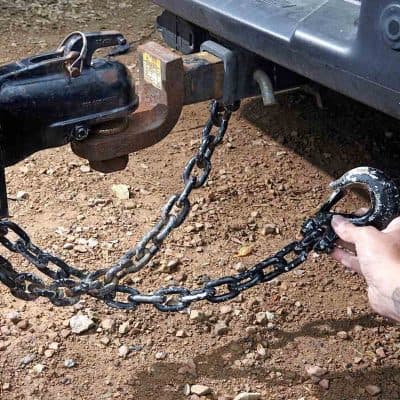
Sani-Dump: another term for dump station, where RVers can legally empty their black and gray tanks.
Self-Contained: Self Contained: A term describing an RV that has all the components for living like electricity, plumbing, sleeping, and more without relying on an outside power/water source.
Shore Cord: The external electrical cord that connects the vehicle to a campground electrical hookup.
Shore Power: Electricity that is received from electrical hook-ups into an RV.
Side Cameras: Side cameras are cameras installed on the side of a motorhome to assist the driver when switching lanes or backing up. A monitor is usually located in the dashboard of the RV. The appropriate camera is shown on the monitor whenever the driver uses the run signal.
Skoolie: Skoolies are renovated school buses made into an RV
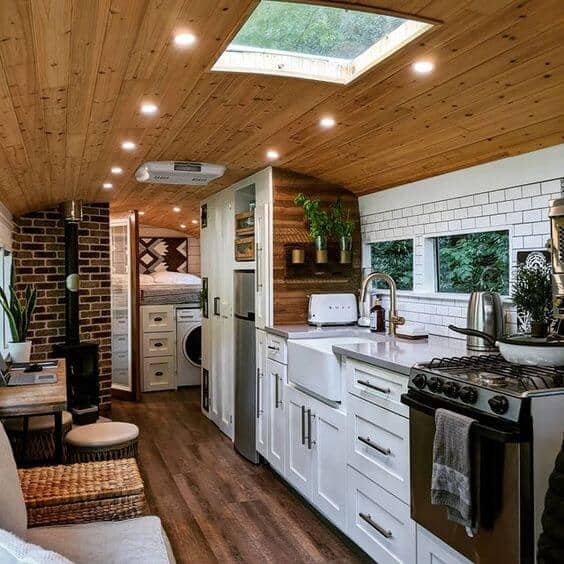
Sleeping Capacity: The number of sleeping spaces in an RV.
Slideout: A slide-out is an expandable room that gives an RV more space. RVs can have as many as 5 slide-outs. They are generally on electronic tracks that come out by pushing a button.
Snowbirds: An RVer that typically lives in their stationary home during the summer and travels to a warmer location in their RV in the winter.
Soft-Sides: Telescoping side panels on an RV that can be raised or lowered, usually constructed of canvas or vinyl and mesh netting.
Solar Panels: Battery chargers that convert sunlight to direct current electricity. May be portable or affixed to the roof of an RV.
Solid Surface Countertops: Solid Surface Countertops are counter surfaces in RVs that are generally made of hard plastic, granite, or other high-quality material.
Spare Tire: This is an extra tire usually mounted on the back or underneath an RV to be used in case of a flat or blown out tire.
Stabilizers: An RV stabilizer is a metal arm that’s installed into your RV’s frame and designed to extend from the frame of the RV onto the ground. When you’re on the road, your jacks should be retracted to the frame. When you’re parked, you’ll fully extend them until they touch the ground. They are used to decrease or eliminate movement of the RV. They are not to be used to level an RV
Stealth Camping: Stealth camping is sleeping in your vehicle without drawing attention to yourself. Most common among van dwellers.
Sticks N Bricks: What RVers call a regular type of house. Refers to stationary home, literally made of sticks and bricks. This can be a house or an apartment, or basically, a dwelling that is not an RV.
Stinky Slinky: The flexible sewer hose used to dump the RV waste tanks.
Streetside: The part of the vehicle on the street side when parked. The driver side.
Surge Supressor: Protect your RV against voltage fluctuations, power surges and incorrectly wired pedestals which can damage RV appliances and electronics.
Sway Bar System: Equipment designed to reduce or eliminate side-to-side sway movement of a towable RV.
T
Tail Swing: Describes the extra distance the rear end of the RV uses during a turn. The longer the space between the rear wheel and the end of the RV the larger the tail swing will be. It is very important to know how much tail swing your RV has when turning corners in tight situations.
Telescoping: Compacting from front to back and/or top to bottom to make the living unit smaller for towing and storage.
Thermocouple: A thermocouple is a sensor that can measure temperature using two different metals when heated.
Three-Way Refrigerators: These are RV refrigerators with the ability to run off electricity, propane, or 12V batteries. .
Tip-Out: A Tip out is a type of slide-out that comes out by “tipping” and not electronically.
Toad: this refers to the vehicle towed by a motorhome. Also known as a dinghy.
Tongue Weight (TW): The actual weight pressing down on the hitch ball located on the tow vehicle. Generally, the tongue weight is 10% to 15% of the gross vehicle weight (GVW).
TT: Is an abbreviation used in the RV industry for Travel Trailer.
TV: Tow vehicle, The vehicle doing the towing such as a truck pulling a trailer.
Tow Dolly: In the RV industry, a Tow Dolly is generally a half trailer that is used to tow a smaller vehicle behind a motorhome, travel trailer, or fifth wheel. It lifts two wheels off the ground for towing.
Tow Rating: The maximum weight a tow vehicle can safely tow, determined by the vehicle manufacturer. Consult the vehicle manufacturer or use a towing guide to find out the towing capacity of a particular vehicle.
Toy Hauler: Travel trailers, motorhomes, or 5th wheels that have the ability to carry ATVs, motorcycles, golf carts, and small cars. Most toy haulers have a garage with a ramp in the back end of the RV.

Trailer Brakes: Trailer brakes are installed on a travel trailer or fifth wheel and are controlled in sync with the tow vehicle brakes.
Transmission Cooler: A heat exchanger that lets the transmission fluid flow through and is cooled by air.
Travel Trailer: These towable trailers are bumper pulled RVs. Smaller travel trailers can be towed with an SUV, cars, and your truck. They generally in size from 10ft – 35ft.

Triple Tow: Towing two items at the same time. This could include a truck towing a fifth wheel and boat or another trailer, a motorhome towing a trailer and a toad, or even a motorhome towing a vehicle and a boat. This is illegal in some states.
Truck Camper: A type of RV that attaches to and sits over the truck bed.

Turning Radius: Refers to the minimum diameter of available space required for that vehicle to make a circular turn.
U
Undercarriage: Refers to everything underneath the RV, including mechanical parts, pipes, holding tanks, and more.
Underbelly: Term used to describe the bottom surface of an RV; similar to the undercarriage.
UVW (Unloaded Vehicle Weight): The weight without full fuel, water, LPG, driver, and passenger weights.
UTQG (Uniform Tire Quality Grading): A system developed by the Department of Transportation, which helps consumers compare and rate tires on tread wear, traction, and temperature.
V
Van Conversion: A van conversion is a van that has been converted into an RV. type These are similar to Class B RVs.

Vintage Camper: Any type of RV (motorhome, trailer, etc.) that is twenty-five years old or older. Many of these have been restored to like-new condition.
W
Walk Through: A “Walk Through” is a term used in RV sales that refers to the process of a sales consultant or technician showing a consumer the features of an RV and how they work. This is part of taking possession of the RV and can take several hours.
Wallydocking: refers to dry camping in a Walmart parking lot.
Washboard Road: Washboarding or corrugation of roads comprises a series of ripples, which occur with the passage of wheels rolling over unpaved roads at speeds sufficient to cause bouncing of the wheel on the initially unrippled surface and take on the appearance of a laundry washboard.
Weekenders: RV owners who travel and use an RV primarily on weekends throughout the year.
Weight Distributing Hitch: This hitch uses a combination of spring bars under tension in order to distribute weight to the front axles of the tow vehicle and trailer axles.
Wet Bath: A wet bath is a small bathroom (sink, shower, and toilet) that is finished so that all surfaces can be wet or damp. Normally found in small RVs.
Wet Weight: This refers to the weight of your RV when all fluids are topped of like a freshwater tank, fuel, etc.
Widebody: Designs that stretch RVs from the traditional 96-inch width to 100 or 102 inches.
Width: The side to side measurement of an RV (doesn’t include the added width of extended slide-outs).
Winterizing: Winterizing is a process to prepare an RV for cold weather. It involves making sure that all water is drained from pipes and water heaters in an RV. If not done properly, damage to some RV components may result.
Wheelbase: The distance between the front wheels and back wheels.
Wheel Chocks: Blocks used to keep the RV wheels in place and prevent it from rolling when parked.
Workamping: Generally refers to RVers exchanging work in exchange for a campsite, utilities, and possibly a small wage. Full-time RV-ers usually do this to travel without extra expense.
Y
Yaw: The movement of a travel trailer or motorhome off of its normal course from left or right.
Numeric
30 AMP Hookup: A 30 amp plug has three prongs – a 120 volt hot wire, a neutral wire and a ground wire – and is generally used on RVs with lower load requirements.

50 AMP Hookup: A 50 amp plug has four prongs – two 120 volt hot wires, a neutral wire and a ground wire – that supply two separate 50 amp, 120 volt feeds.
4-Pin Electrical Connector: This provides power from your tow vehicle to your RV for the lights only.
7-Pin Electrical Connector: This provides power from your tow vehicle to your RV for the lights as well as the electrically operated brakes.
This is amazing. How long did it take you to write this whole post??? Great job Juley!
Ha! Three full days! Thanks!